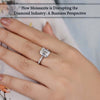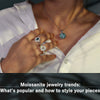
Moissanite myths debunked: Separating fact from fiction about the stone
Table Of Contents
- Introduction
- Myth 1: Natural Moissanite is Used in Jewelry
- Myth 2: Moissanite is a Fake Diamond
- Myth 3: Moissanite is Cubic Zirconia
- Myth 4: Moissanite is Basically a Lab-Grown Diamond
- Myth 5: Moissanite is Harder Than Diamond
- Myth 6: Moissanite is Tacky
- Myth 7: Moissanite is Expensive
- Myth 8: Moissanite is of Poor Quality
- Conclusion
Introduction
When a new gemstone enters the market, the lack of information and knowledge about it becomes apparent. Masses form a common notion, which takes the form of myths. The same has happened with the gemstone moissanite, which looks like diamonds and has splendid brilliance and sparkle. A charming and dazzling stone has become a victim of falsified facts. Therefore, it is vital to debunk these myths and spread the requisite information. This article will give you straight facts about moissanite and no fiction. Let’s sweep away moissanite myths one at a time so you can purchase from Diamondrensu without hesitation.
Pear Cut Green Moissanite Engagement Ring
Myth 1: Natural Moissanite is Used in Jewelry
Well, natural moissanite diamond is rare to find in nature. One of the facts about moissanite is that miners had not unearthed it for the first time. This unique mineral (naturally-occurring silicon carbide) was discovered two years after the production of synthetic silicon carbide. While the latter had already been present for industrial purposes, the world got introduced to natural moissanite found in a large crater in Arizona, USA. A meteor had created this crater, and this discovery happened in the late 1800s. Henri Moissan, a French chemist and Nobel Prize winner, is credited with the discovery, and the gemstone also derives its name from him.
Given its sporadic existence, using natural moissanite stone in jewelry is not feasible. Even shaping a one-carat gemstone from the mined moissanite is impossible and commercially unviable. The moissanite rings, wedding bands, earrings, and other ornaments you see are lab-made moissanite stones. Lab technicians create moissanite in a controlled environment using the Czochralski method, wherein crystals form from a single seed. Jewelers use synthetic silicon carbide or lab-created moissanite as a diamond simulant, offering a cheaper alternative to a diamond.
Myth 2: Moissanite is a Fake Diamond
For the uninitiated, moissanite can appear as a fake or even an authentic diamond. The similarity between the two is uncanny, and it is easy to get confused. However, moissanite is simply a diamond simulant that resembles diamonds but possesses different physical and chemical properties.
On the Mohs hardness scale, diamond scores a perfect ten, making it the hardest-known mineral on Earth. Alternatively, moissanite is hard but does not match the diamond’s score. It ranks 9.25 to 9.50 on the Mohs scale and thus differs on the hardness quotient.
Diamond, moissanite, and other stones are also identified based on brilliance. It is one characteristic that separates moissanite from diamond. The former depicts more brilliance or sparkle than a diamond. It happens because of the process of double refraction in the case of moissanite, while diamond shows single refraction. When you rotate a diamond, it gives off white light but a moissanite fashions a rainbow-like appearance. With this one difference in feature, you can distinguish between a diamond and a moissanite.
Moissanite is, therefore, not a fake diamond, as the popular myths about moissanite go. It is another name for a gemstone made of silicon carbide, while a diamond comprises carbon atoms. Due to the close resemblance and nearly similar properties, you can consider moissanite a cheaper substitute for diamond and nothing more!
5.63 TCW Radiant Brilliant Cut Colorless Moissanite Wedding Ring
Myth 3: Moissanite is Cubic Zirconia
Cubic Zirconia is another diamond simulant like moissanite, which bears semblance to diamonds but has varying characteristics. However, this cubic Zirconia is often mistaken to be the same as moissanite. Let’s bust one of the most prevalent myths about moissanite once and for all.
Moissanite’s presence in nature is not unheard of, although in small quantities. Cubic Zirconia, on the other hand, is an artificial creation. Its primary component is zirconium dioxide, made in laboratories in a controlled environment. Meanwhile, moissanite is the official name for silicon carbide and thus differs chemically from Cubic Zirconia.
Furthermore, cubic Zirconia does not possess moissanite’s intensity of fire and brilliance. Due to a lower refractive index, it does not sparkle as much as moissanite. You can differentiate between the two through the naked eye.
Another point of difference between the two diamond simulants is the hardness quotient. Cubic Zirconia ranks 8 to 8.5 on the Mohs hardness scale, still solid but lower than moissanite. On the price front, moissanite is more expensive than Cubic Zirconia because of its unique features and rarity.
Thus, moissanite is not Cubic Zirconia as perceived by many. So, if you are jewelry shopping, you must understand their differences.
Myth 4: Moissanite is Basically a Lab-Grown Diamond
Lab-grown diamonds’ popularity has been on a steady rise due to several reasons. Earth-mined diamonds take billions of years to form, and mining harms the environment, making it unsustainable. Moreover, the inhuman treatment meted out to miners in various instances does not make the usage of natural diamonds ethical. Thus, lab-engineered diamonds have made their way into the jewelry world, just like moissanite.
However, one of the most prominent moissanite myths is to equate it with a lab-grown diamond. The latter is a diamond created by replicating conditions beneath the Earth’s crust. It has the same crystal structure as a mined diamond, with a single carbon atom bonding with four other carbon atoms. The hardness, durability, brilliance, and other properties remain the same. Essentially, there’s no difference between a natural and a lab-made diamond except the price, with the latter being cost-effective.
On the other hand, laboratories may create moissanite due to its rare occurrence in nature, but the gemstone’s intrinsic qualities differ from a lab-grown diamond. Moissanite does not contain pure carbon atoms but is silicon carbide. It dazzles more than a lab-generated diamond due to a higher refractive index and is more affordable for buyers.
Myth 5: Moissanite is Harder Than Diamond
Another one of the most widely accepted myths about moissanite is that it is harder than diamond. With moissanite being durable and scratch resistant, it must not surprise you where this belief comes from, but it is far from true.
Diamond is still the hardest-known mineral. On the Mohs scale of mineral hardness, which ranges from one to ten, a diamond hits the bull’s eye, scoring a ten. It is nearly impossible to scuff up a diamond. On the other hand, moissanite’s hardness score ranges from 9.25 to 9.50. Compared to several other gemstones, moissanite is tougher and more durable but falls behind in the case of a diamond.
Myth 6: Moissanite is Tacky
If you have heard that moissanite is tacky, you have got it all wrong. It is not an imitation of diamonds or knock-off diamonds. The gemstone has unique qualities and properties, which grants it an identity among the most sought-after jewelry accompaniment worldwide. It is not crude and cheap-looking but a highly-refined mineral. You can check out an eye-catching collection of moissanite-based ornaments and moissanite earrings at Diamondrensu and confirm its quality for yourself.
Antique Butterfly Cut Yellow Moissanite
Myth 7: Moissanite is Expensive
Another common myth about moissanite is that it is expensive, but this is not entirely true. While moissanite remains costlier than other gemstones like sapphire, it is still cheaper than diamond. The cost of moissanite gemstone varies based on the cut, size, and quality, but you can depend on it to be affordable. For instance, a one-carat diamond can cost you several thousand dollars, but you can purchase a moissanite jewelry piece for a few hundred dollars. Therefore, moissanite is not as big-budget a purchase as you deem it to be.
Myth 8: Moissanite is of Poor Quality
Moissanite is among the most cherished gemstones, and calling it inferior or of poor quality is ludicrous. The gemstone’s brilliance, implying its ability to reflect light to the observer, is comparable to a few. Moreover, its inherent fire, meaning the range of colors it depicts when viewed under different lighting environments, is second best to none. Moissanite’s luster makes it resemble a diamond, often confusing unaware buyers. The gemstone is scratch-resistant and scores bonus points on durability. What more would you need in a gemstone beautifying your ring, earring, or pendant? Moissanite engagement rings have glamour and the required strength to last long. Therefore, do not let these erroneous facts about moissanite fool you.
Toi Et Moi Ring, 11.31 TW Pear Cut Unique Moissanite Engagement Ring
Conclusion
Reputed jewelry brands accept moissanite as a quality alternative to diamonds, Diamondrensu being one among them. They reject moissanite myths, and so should you! At Diamondrensu, moissanite is a highly sought-after gemstone, demanded in the form of rings, wedding bands, pendants, earrings, and even loose stones. You can choose a classic solitaire moissanite ring or opt for a fancy-colored model. Diamondrensu gives you a tough time selecting a piece, leaving you spoilt for choices. Customization is also the brand’s specialty; you can alter the design or add a personalized message per your whims.
Therefore, head over to Diamondrensu and order an exquisite piece of jewelry now. Geographical barriers must not restrain you from ordering, as Diamondrensu ships worldwide. Moreover, you do not need to pay any convenience or delivery fee. Furthermore, you will not get a better market price for jewelry anywhere. If you have any queries, customer support is at your service 24*7. Shop now!
Leave a comment
Please note, comments must be approved before they are published.














